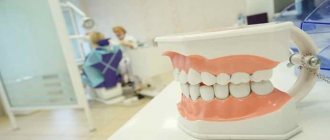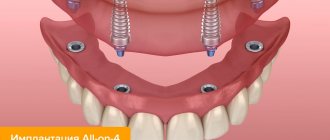Problem: a woman came to Family Dental on the advice of friends - she was looking for a clinic where she could restore two missing teeth in her upper jaw. During the diagnosis, the congenital absence of several teeth (primary adentia) and the long-term absence of one of the upper teeth due to extraction (secondary adentia) were discovered. The absence of teeth caused displacement of neighboring teeth and malocclusion.
Solution: the bite was corrected using Damon braces (the normal closure of the upper and lower teeth was restored), a place was prepared for prosthetics of the two upper teeth, 2 Astra Tech dental implants were installed, 13 teeth were replaced with ceramic crowns (E.max ceramics and zirconium dioxide).
Consultation, diagnosis and development of a comprehensive treatment plan
The woman had her central front tooth removed in another clinic because the tooth had decayed. At that time, she was not ready to install a dental implant, so the tooth was covered with a suspended structure to restore minimal aesthetics:
On the upper left there is no one more tooth (long ago removed due to destruction), and there is a gap between the teeth.
After some time, the woman began to look for a clinic where she could have two teeth restored with implants so that it would be beautiful. On the advice of friends, she turned to the Family Dentistry to orthopedic dentist A.S. Ivankov.
At the consultation, it turned out that, apart from the two removed teeth, there were no fifth teeth from birth (primary adentia), that is, there were milk teeth, but the permanent teeth did not grow during the change of teeth. Since this was a long time ago, the remaining teeth have shifted, and the missing teeth have closed almost completely. Due to the displacement of the teeth, the bite is disturbed, and in some places the upper teeth overlap the lower teeth (crossbite). An incorrect bite causes overload of certain groups of teeth, so there are areas of receding gums (gingival recession) in the area of the lower front teeth.
The orthopedic dentist advised us to start preparing for prosthetics by correcting the bite. Once the correct closure of the teeth has been restored and the place for prosthetic replacement of the two upper teeth has been prepared, it will be possible to install dental implants and crowns on implants. In a correct bite there will be no overload zones, implants and crowns will last longer.
The patient consulted orthodontist M.P. Sleptsova, calculations were made using dental casts and x-rays (panoramic, TRG in lateral projection). The patient also visited an osteopath, who at Dial-Dent always takes part in the diagnosis and treatment of orthodontic patients, since all changes in the position of the teeth affect posture, the functioning of the muscles and joints of the head and neck, and the functioning of the body as a whole.
The treatment plan was drawn up at a joint consultation of an orthopedic dentist and an orthodontist - the main specialists in this treatment. The patient’s desire was this: to make it beautiful and functional, but there is no need for perfect aesthetics, it’s better to have fewer interventions. Since the 5th teeth are missing evenly in all segments, and the gaps from them are almost completely closed, it was decided not to expand the teeth in these places, but, on the contrary, to move them, finally closing the gaps between the teeth, and create even dentition. The chewing teeth are worn down and destroyed by caries, the bite needs to be made higher, so after treatment with braces, the missing height of the teeth will be restored by dental crowns.
Treatment plan:
- Hygienic preparation for complex treatment.
- Re-treatment of the canals of one upper chewing tooth with a microscope, replacement of the old pin in the tooth with a new one made of fiberglass (since there will be a ceramic crown), treatment of dental caries.
- Orthodontic treatment – expansion of the upper dentition and restoration of normal closure of the teeth, preparation of a site for the installation of 2 dental implants in the area of the central and fourth tooth on the upper jaw on the left with displacement of the canine to the center, closing the gaps between the teeth on the lower jaw.
- Osteopathic correction throughout the entire orthodontic treatment.
- Installation of two Astra Tech dental implants.
- Dental prosthetics with ceramics (on implants and three front upper teeth with ceramic crowns made of E.max ceramics, and on chewing teeth with crowns made of zirconium dioxide).
The issue of eliminating gum recession (transplanting soft tissues into the recession zone) remained outside the treatment plan for now, since the patient did not want to increase the scope of surgery. It was decided to monitor the gums after orthodontic treatment, since in this case the cause of recession is precisely the overload of groups of teeth due to malocclusion, and after eliminating the overload, the recession can stabilize.
The estimate for treatment described in detail all the stages, their sequence, duration, and the cost of treatment at each stage (payment in stages). Treatment according to a pre-compiled estimate is much more convenient for the patient - there are no unexpected unpleasant surprises, the final amount of expenses and the time required for treatment are clear.
Commentary by the chief physician of Dial-Dent, orthopedic dentist S.V. Tsukora: “Some try to save money by carrying out different stages of treatment in different clinics (one has a familiar therapist, and another offers a special offer to brush your teeth). With this approach, there is no guarantee for the entire treatment; you often have to redo someone else’s work because it is not consistent with the final result.
The right approach in difficult cases is to look for a clinic where a team of doctors works and the treatment is carried out thoughtfully, step by step! After completion of treatment, the clinic will be able to provide a guarantee for all work performed. The patient must also follow preventive measures after treatment - come for examination, have professional teeth cleaning. If all this is done in one clinic, then there will be no problems for many years.”
Is it possible to put braces on crowns?
Installation of orthodontic brackets on an artificial crown is also possible. Treatment of malocclusion occurs thanks to living roots under the prosthesis, capable of moving in the direction specified by the brace system.
But most likely you will have to give up wearing inconspicuous lingual or aesthetic ceramic models, opting for a metal structure. This is due to the better adhesion of a metal lock to the surface of an artificial crown in comparison with retention elements made of other materials.
You will also have to carefully care for the oral cavity until the correct bite is formed, protecting the braces from mechanical stress. It is worth giving up hard, sticky foods, taking care to maintain a reliable fixation of the system.
Attaching a bridge prosthesis to supporting teeth is also not a problem. The orthodontist may recommend temporarily removing the bridge and installing temporary crowns, or suggest sawing the prosthesis into several parts to protect it from destruction.
Correction of bite – treatment with braces
Treatment with braces lasted 2 years. Damon self-ligating braces were used for treatment. Ceramic braces were installed on the front teeth, which created greater comfort for the patient, since they are hardly noticeable on the teeth.
Due to crossbite in some areas, overbites were placed on the lower teeth at the beginning of treatment.
After achieving proper closure of the teeth, the onlays are removed without leaving any traces.
The patient visited the orthodontist every 1.5 months.
Osteopathic correction was carried out after almost every visit to the orthodontist. The osteopath relieves accumulated tension in the bones of the skull and masticatory muscles, which facilitates the movement of teeth and reduces pain after installing new equipment or replacing arches. Treatment by an osteopath helps stabilize the result of bite correction.
As a result of orthodontic treatment, the dentition is aligned and space is created for prosthetics of the two upper teeth.
To temporarily restore the aesthetics of a smile, the missing central tooth is hidden using a hinged structure.
Brief summary
How long you wear braces on your teeth depends on many factors. The summary table will help you navigate the average time frame, depending on the existing defect that requires correction:
| Deadlines | Defect requiring correction |
| 1-1.5 years | Correction of minor anomalies:
|
| From 2 years | For severe pathologies:
|
| Up to 3 years or more | Correction of the most serious and even rare defects, some of which require preliminary surgical intervention. |
Do not forget that after removing the braces, the treatment does not end, since from this moment the retention stage begins. Its duration can vary from 3-6 years, and in particularly difficult cases - throughout life.
Installation of dental implants
Two Astra Tech dental implants (Sweden) were installed. These are reliable implants that have been installed at Dial-Dent for more than 15 years. Astra Tech implants perfectly into bones due to the quality, as well as modern materials and technologies used in their manufacture.
After 4 months it was possible to begin dental prosthetics.
Dental prosthetics with ceramics
After correcting the bite, the gum recession stopped, as the overload of the teeth was eliminated, the patient did not complain about tooth sensitivity, and did not want to have another operation for the sake of aesthetics, so a soft tissue transplant was not performed and the gum level was not changed. This is decided before dental prosthetics, since the shape of the dental crowns depends on the level of the gums.
At the first stage of prosthetics, wax modeling was performed - models of dental crowns were made from wax so that the patient could evaluate the type of restorations before preparing the teeth.
Temporary dental crowns are then made from the wax models. Temporary dentures help the patient get used to the new sensations of teeth closing and appearance. You can make adjustments at this stage to make permanent crowns more perfect. In addition, temporary crowns are needed so that the gums take the desired shape in the area of the implants, since there have been no teeth there for a long time, and the gums become smooth, but should look like an arch.
A few weeks later, when the gums had returned to normal shape, impressions were taken for permanent ceramic crowns.
Dental crowns were made in Dial-Dent’s own dental laboratory (teeth with crowns are marked on jaw models):
Prosthetics of the front teeth requires excellent aesthetics, so crowns for all front teeth are made of E.max ceramics (including implants). E.max ceramics make it possible to make very thin restorations characterized by the natural translucency of the enamel. To make teeth on implants look natural, the abutment (the base for the crown installed on the implant) is also made of ceramic. For chewing teeth, strength is more important, so the crowns for the chewing group are made of zirconium dioxide.
Dial-Dent specialists who restored the beauty of your smile
- Orthopedic dentist A.S. Ivankov - treatment planning, coordination of specialists’ work, dental prosthetics with ceramic crowns.
- Orthodontist M.P. Sleptsova - treatment with braces, preparation for dental prosthetics.
- Implant surgeon V.P. Alaverdov – installation of dental implants.
- Osteopathic doctor V.V. Bystrov – osteopathic correction during the period of occlusion correction.
- Dentist-therapist T.I. Matienko – treatment of dental caries, treatment of canals with a microscope.
- Dental hygienist E. Smirnova – professional dental hygiene.
- Dental technician D.V. Wolf – making dental crowns from ceramics.
- Dental assistants – S. Shchelkova, A. Antoshkina, M. Erkimbekova.
See other examples of the work of Dial-Dent specialists here.
Make an appointment for a consultation by phone +7-499-110-18-04 or through the form on the website. You can ask questions about dental prosthetics to the chief doctor of the clinic, Sergei Vladimirovich Tsukor, at
Braces and implantation. Wearing braces and implants together – is it possible or not?
Content:
- Installing an implant while wearing braces
- Braces and implantation
- Is it possible to put braces after implantation?
Many patients in dental clinics require not only bite correction, but also restoration of lost teeth. Therefore, a natural question often arises: “Is it possible to install an implant during braces?” Orthodontics and implantation are combined techniques, but each clinical case is individual. Let's look at how to properly combine these two technologies.











